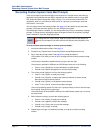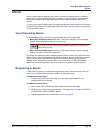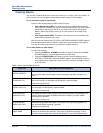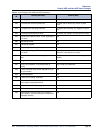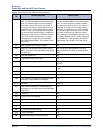
Voice Mail Administration
Alarms
Mitel
®
5000 Enterprise
®
Messaging and Basic Voice Mail Administrator Guide – Issue 3.1, December 2008 Page 19
Alarms
Alarms are generated on endpoints as the result of continuous self-diagnostics run within the
system and are a basic indicator that there is a problem or potential problem with the system.
The severity and type of alarm determines the corrective action necessary to resolve the
problem.
To allow you to monitor multiple nodes, the system provides both system alarms, which includes
voice processing alarms, and network-wide alarms. See Table 1 on page 20 for the complete list
of voice processing alarms.
Voice Processing Alarms
On the Mitel 5000 platform, the following voice processing alarms are generated:
• Minor Voice Processing alarms (020–039): These alarms indicate a voice processing
problem that usually require calling service personnel.
• Major Voice Processing alarms (200–224): These alarms indicate a voice processing
problem that require calling service personnel.
The system Alarm Reporting feature detects equipment failures. If there is a system failure that
affects service, a major alarm appears at all affected endpoints. When a minor equipment failure
occurs, a minor alarm is generated and appears on the primary attendant’s display and, if
enabled, at your administrator endpoint. When a Voice Mail alarm is in effect, the telephone
system may be functioning properly, but the voice processing system may be inoperative.
Responding to Alarms
A major alarm requires you to contact service personnel, while a minor alarm may or may not
require you to contact service personnel in addition to clearing the alarm.
To respond to a major alarm:
Contact service personnel for the major voice processing alarms #200-224. An
equipment failure has occurred.
To respond to a minor alarm:
1. When a minor alarm indication appears, write down the alarm information.
2. While on-hook, clear the alarm as described in “Clearing Alarms” on page 20. SYSTEM
(or NETWORK) ALARM CLEARED appears.
3. Take the appropriate action as indicated in Table 1 on page 20.
NOTE
Even when a voice processing alarm has been registered, the system may
still function correctly.






